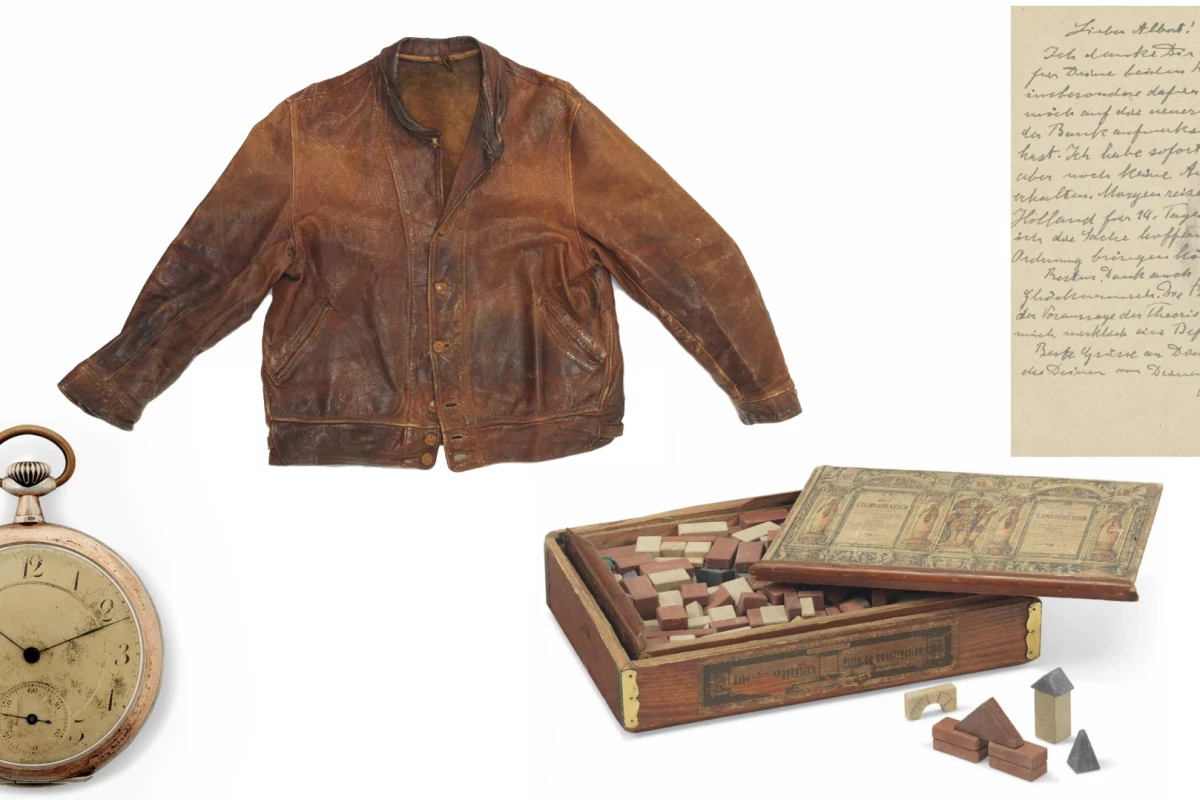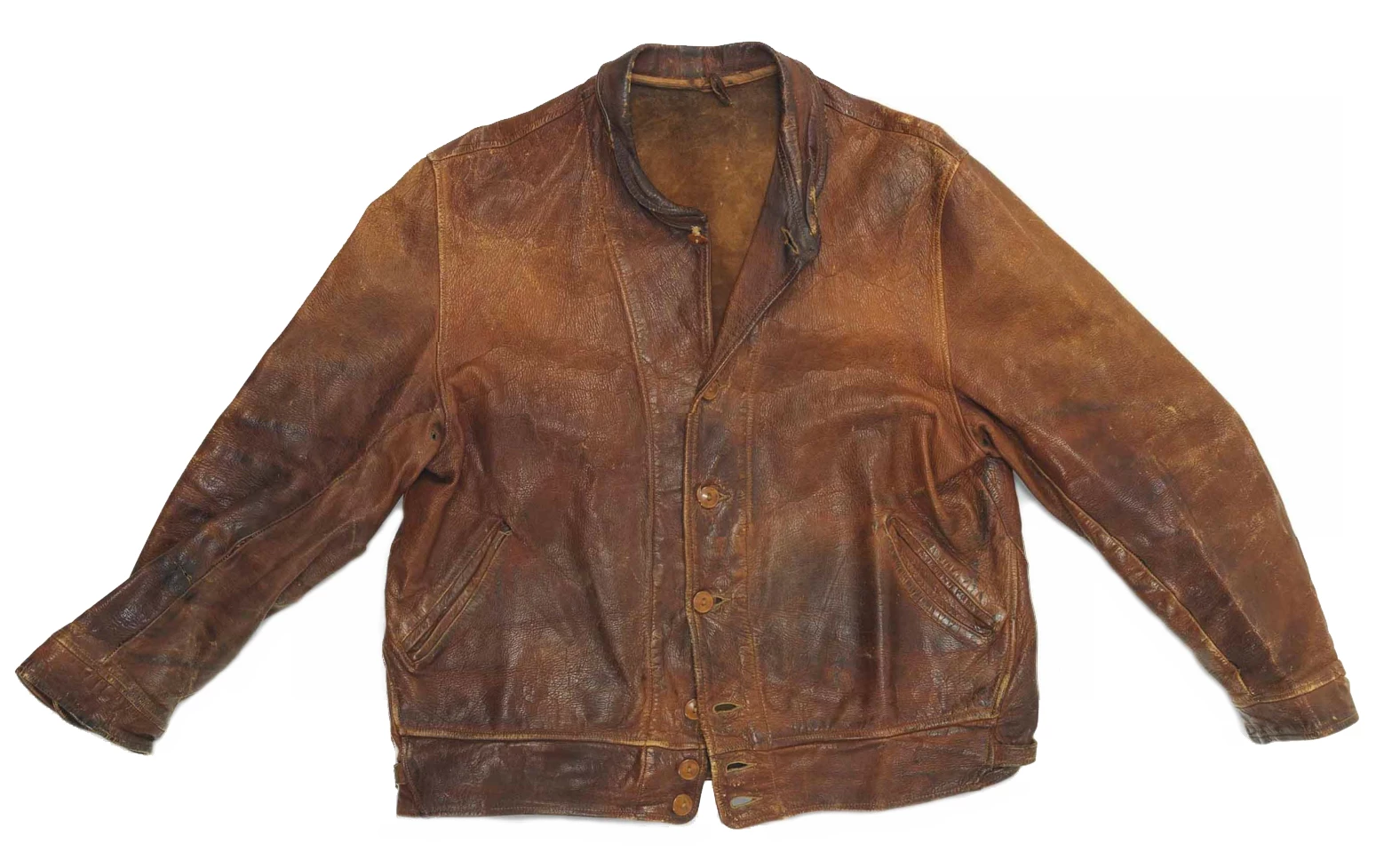The market for scientific memorabilia, scientific instruments and and scientific documents and manuscripts has been undervalued for ... well, forever. Our scientific heritage has long played second fiddle to entertainment, sports and religious memorabilia on the auction block, but movement is afoot.
The bidding strength at Christie's two big auctions in London yesterday indicates that the scientific heritage marketplace may be finally coming to its senses, with many landmark scientific works fetching quite respectable sums, and two lots selling into the top 20 most valuable scientific documents ever sold at auction.
As you may have gathered from our extensive feature on Einstein memorabilia last week, we're devotees of the gentle genius, so let's start with the lots associated with the rock star scientist.
$352,054 – Einstein's Pocket Watch
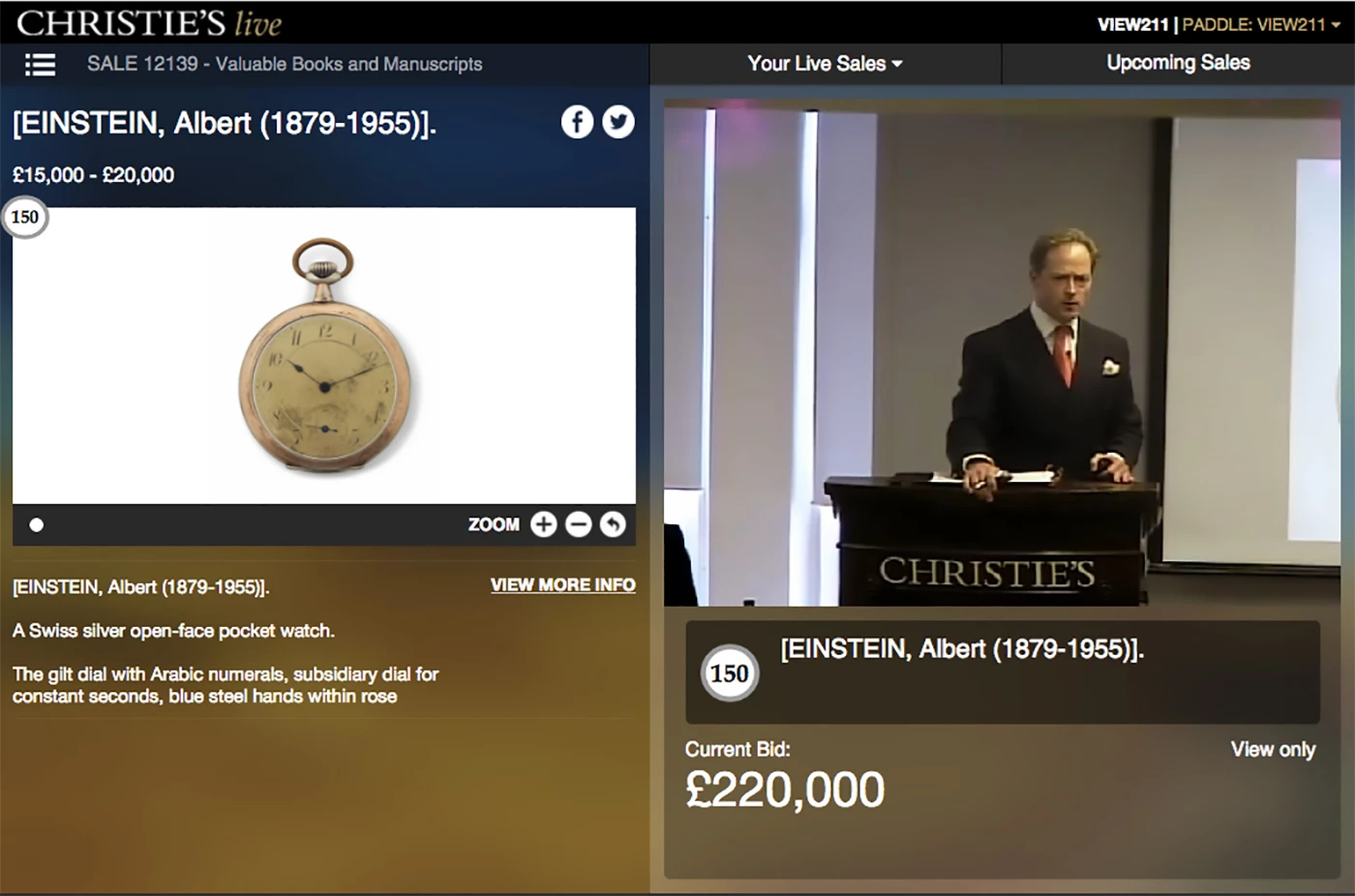
The Einstein highlight turned out not to be his leather jacket (as we expected), but his pocket watch, which fetched more than ten times its estimate. Predicted by Christies to sell for between £15,000 and £20,000, bidding kept going all the way to a hammer price of £220,000 which translated into £266,500 with buyers premium added and a final result in USD of $352,054.
$145,974 – Einstein's Leather Jacket
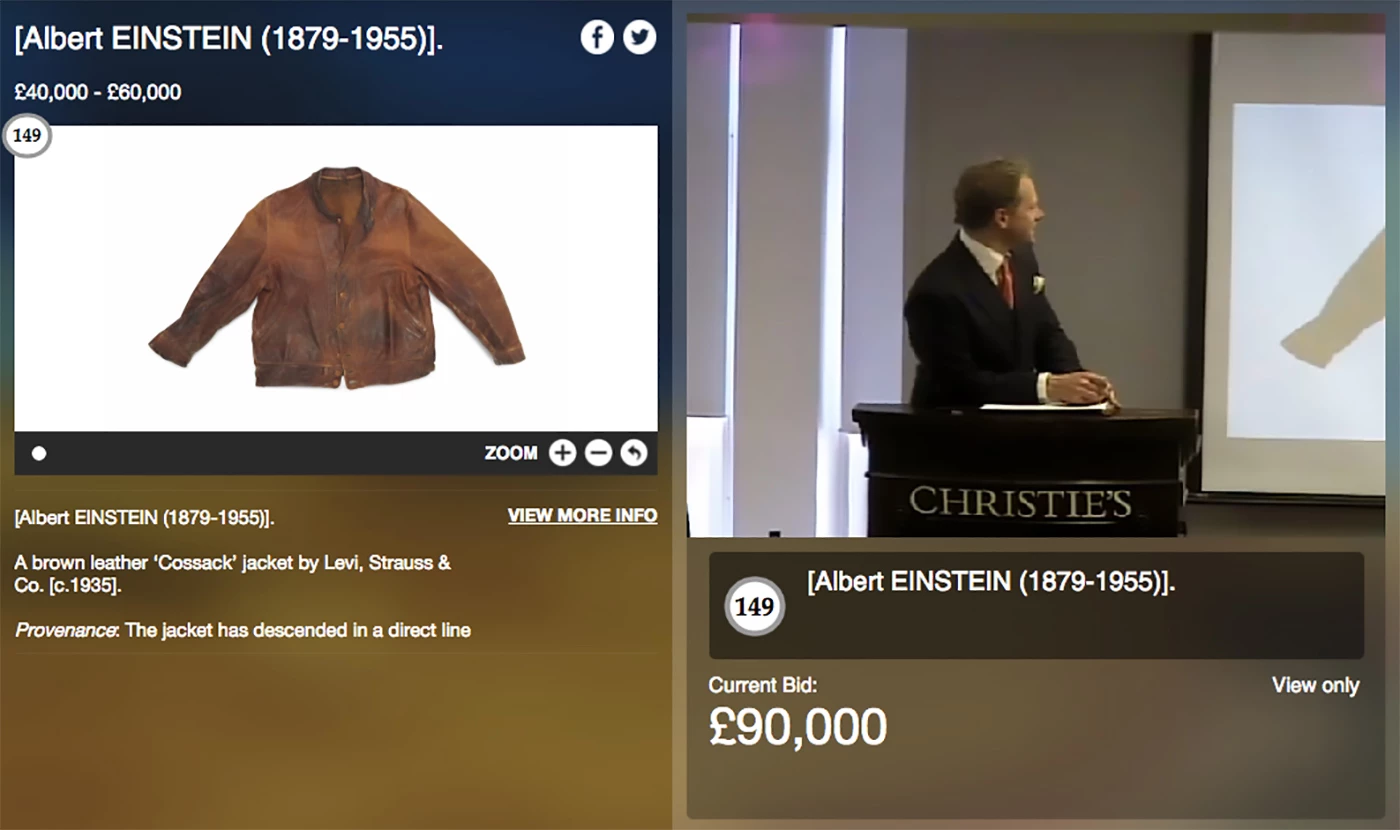
By contrast, Einstein's "putrid" (they obviously don't recognize the smell of genius) leather jacket only doubled its auction estimate of £40,000 to £60,000, hammering at £90,000 (that's screen grab from the Christie's on-line viewing interface above), which translated to £110,500 with buyers premium, which in turn became US$145,974.
$82,564 – Einstein's Childhood Building Blocks
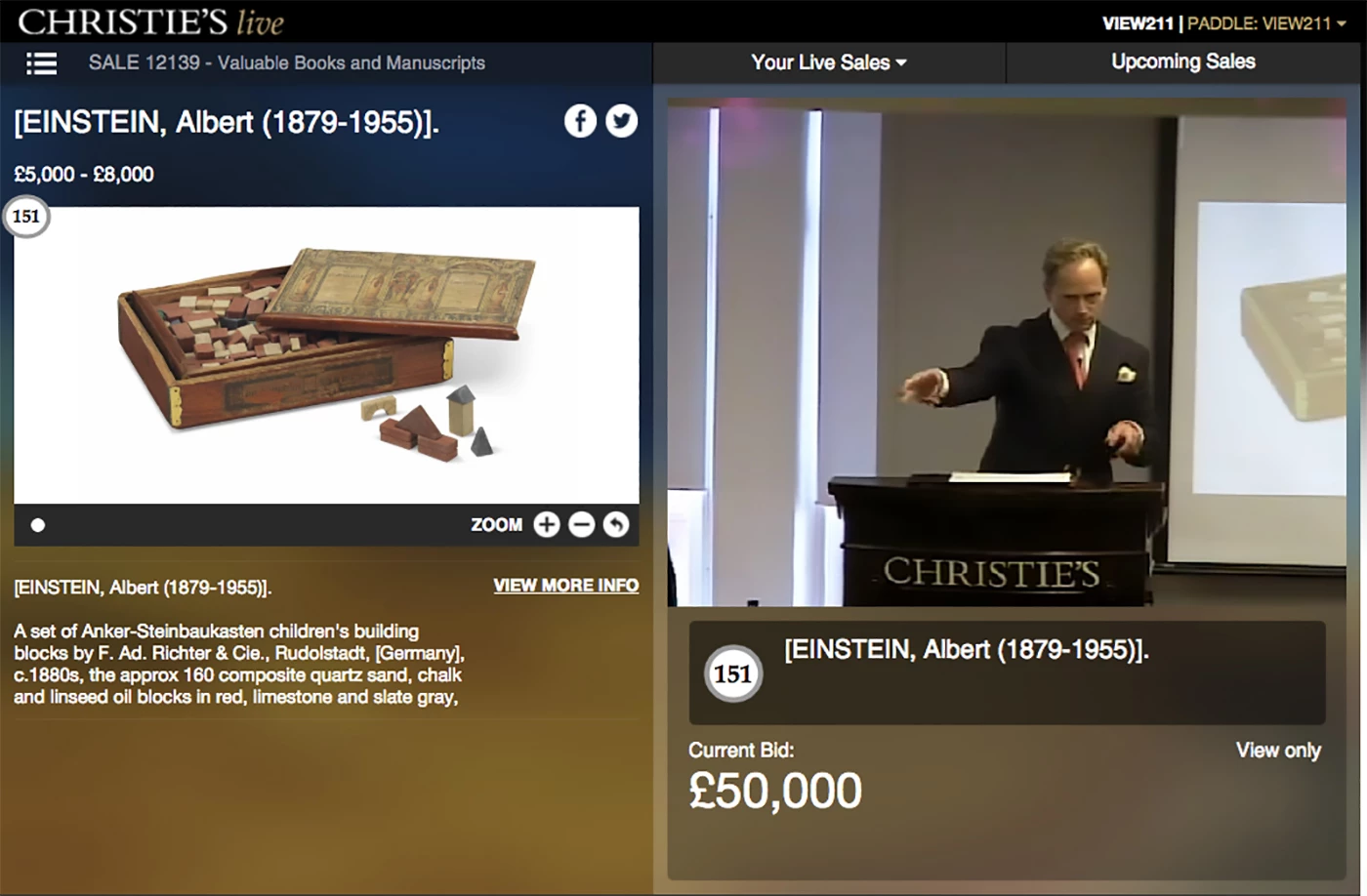
Einstein's childhood building blocks were an even greater surprise package. Estimated to sell for between £5,000 to £8,000, the blocks saw the hammer fall at £50,000, which became £62,500 with buyers premium, or USD$82,564. We had a good laugh in the office this morning wondering what the buyer might do with the blocks. One theory was that there's a parent out there hoping that some residual genius might be be still on the surface of the blocks to rub off on their children, another is that the 160 building blocks could be separated and sold individually (they cost the buyer more than $500 apiece so heaven knows what the asking price might be for each block to make it all worthwhile), and a third theory was that they might be replicated and sold as a set. Of course it could always be a genuine collector who purchased the blocks but ... time will tell.
$98,417 - a postcard from Albert Einstein
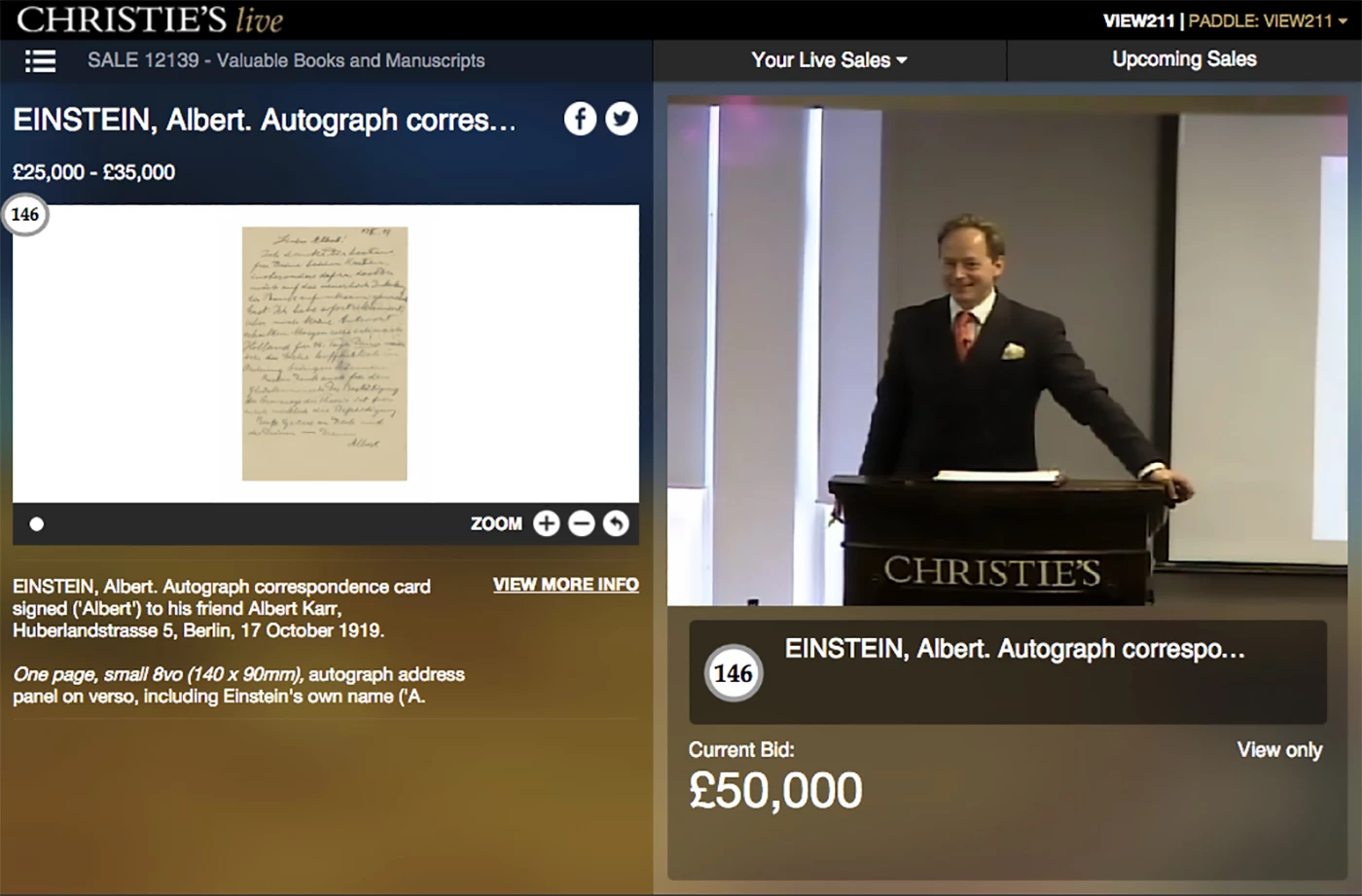
Finally, a 140 x 90mm correspondence card handwritten and signed by Einstein to his friend Albert Karr in 1919, fetched £74,500 ($98,417) from an estimate of £25,000 to £35,000. Again, that's better than double the upper estimate.
In summary, the Einstein "Midas touch" appears to be getting more potent with age. If Einstein memorabilia is an area of interest for you, be sure to see our extensive compendium of Einstein auction results.
A pocket watch, leather jacket and some building blocks may have created the interest in the auctions, but it was the world's most famous flower book, the original book on heliocentric theory and a number of landmark works by Sir Isaac Newton, Galileo Galilei, Johannes Schoner and Luca Pacioli that really lit up Christie's London sales.
$2,550,247 – Hortus Eystettensis by Basilius Besler
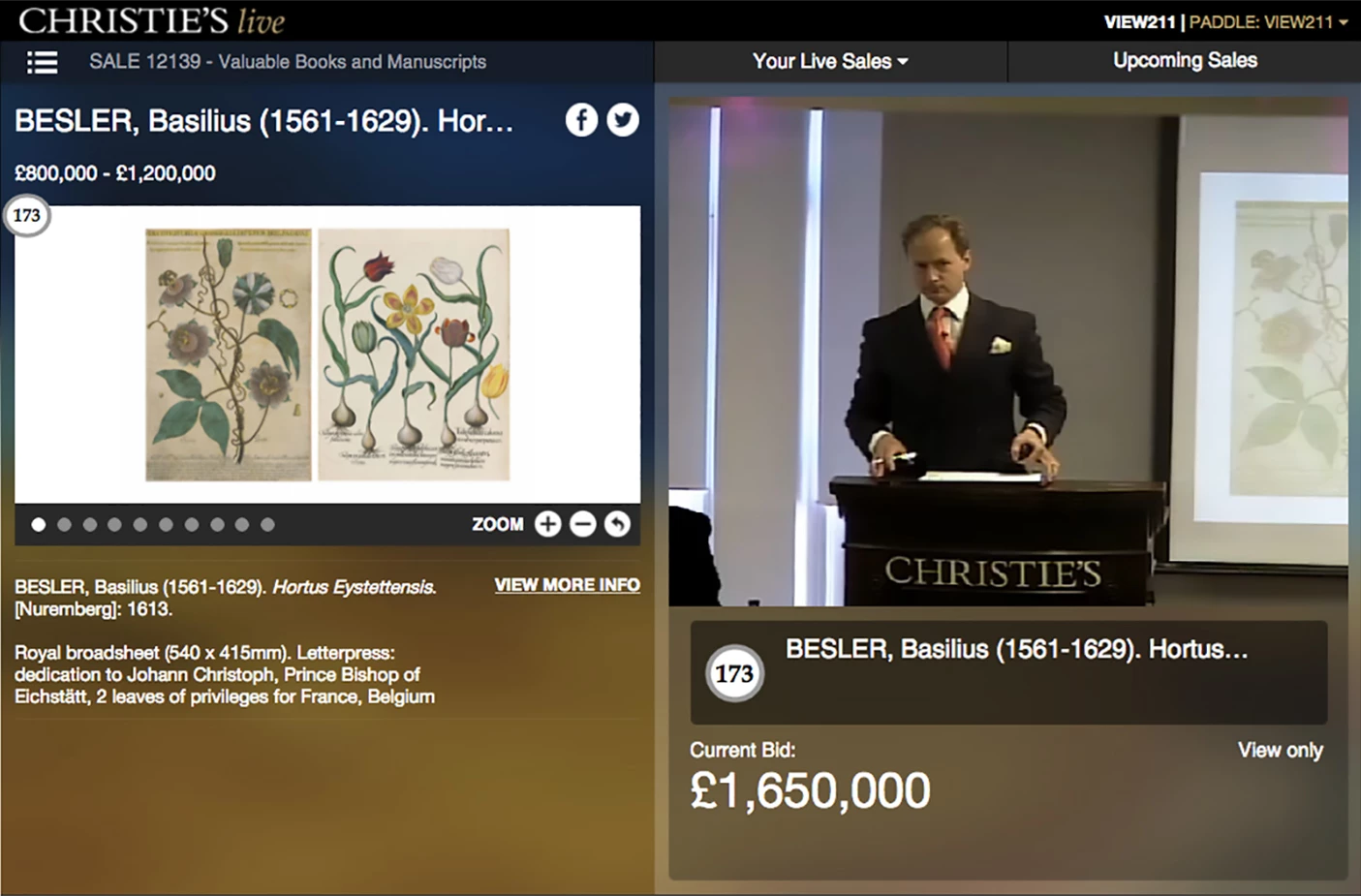
The 400 year-old Hortus Eystettensis by Basilius Besler attracted considerable interest from around the globe as one of just 15 complete copies of the "most famous flower book in the world."
It was already the second most valuable flower book in history with a copy having sold for £993,750 ($1,413,619) at a Christies London auction in November, 2001 so it was no surprise to see it fetch considerably more than the estimate of £800,000 to £1,200,000 (US$1.2 to $1.6 million). When the hammer fell, the final all up price took the book to £1,930,500 ($2,550,247) and a place just outside the top 10 scientific books of all time. The most valuable 'flower book' of all time is currently Les Liliacées by Pierre-Joseph Redouté which sold for $5,500,000 at a Sotheby's (New York) auction in November, 1985.
$2,402,292 – De Libris Revolutionum by Rheticus
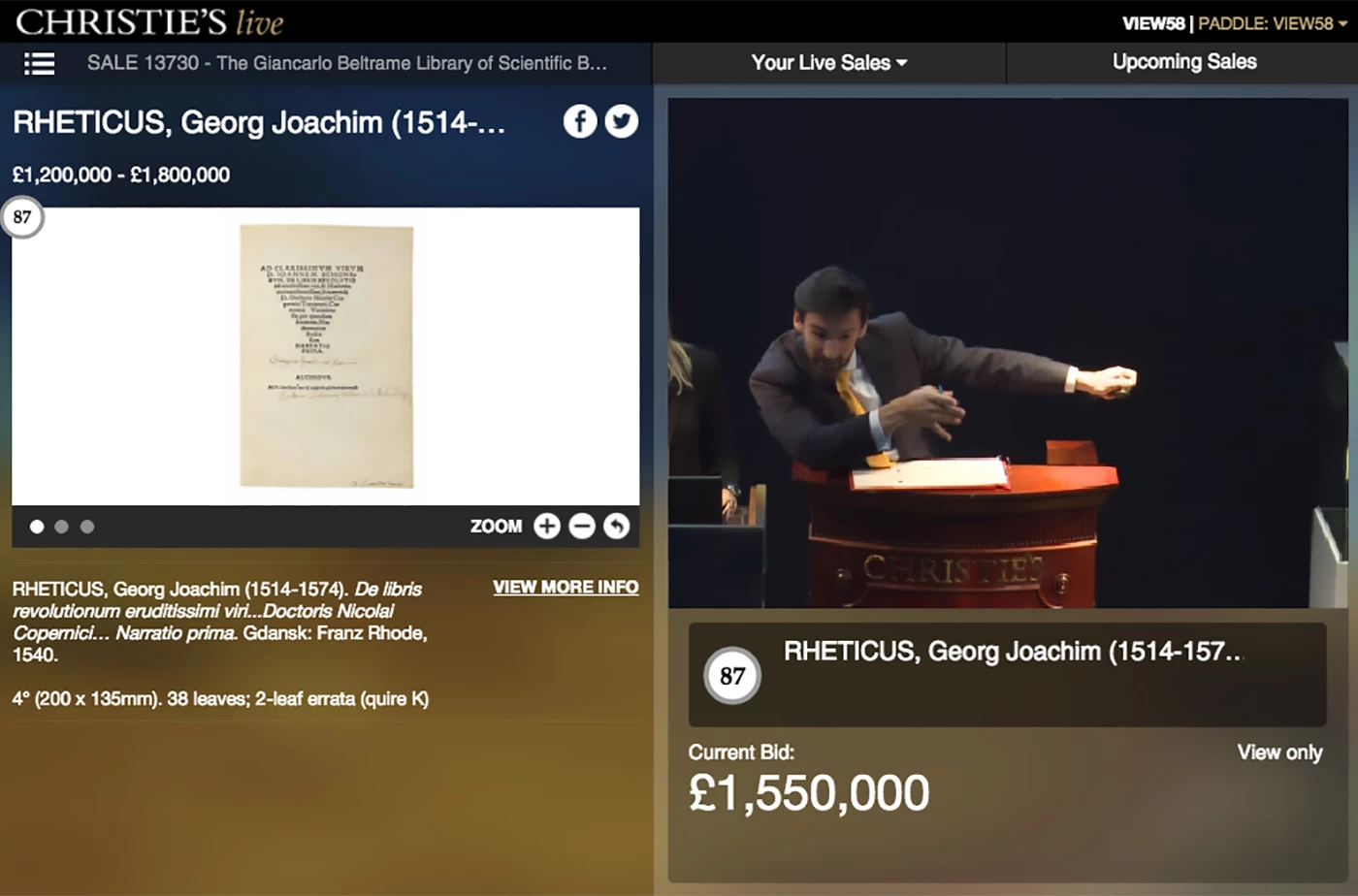
As we predicted last week in our preview of this lot, this copy of De Libris Revolutionum Eruditissimi Viridoctoris sold above it's £1,200,000 – £1,800,000 estimate as it is exceedingly rare and the last time a copy came to auction was at a Sotheby's New York auction in November 1989. In the end, it fetched £1,818,500 ($2,402,292), which is somewhat ironic as the book is the work of Georg Joachim Rheticus, and is based on his studies under Nicolaus Copernicus, the person credited with the heliocentric theory. When published in 1540, this book provided the momentum needed for Copernicus to finally have his landmark De Revolutionibus Orbium Coelestium published in 1543.
The irony comes from the fact that this book sold for more than the most valuable first edition copy of his master's master work which sold for $2,210,500 at a Christie's (New York) auction in June 2008.
$415,464 – Sidereus Nuncius by Galileo Galilei
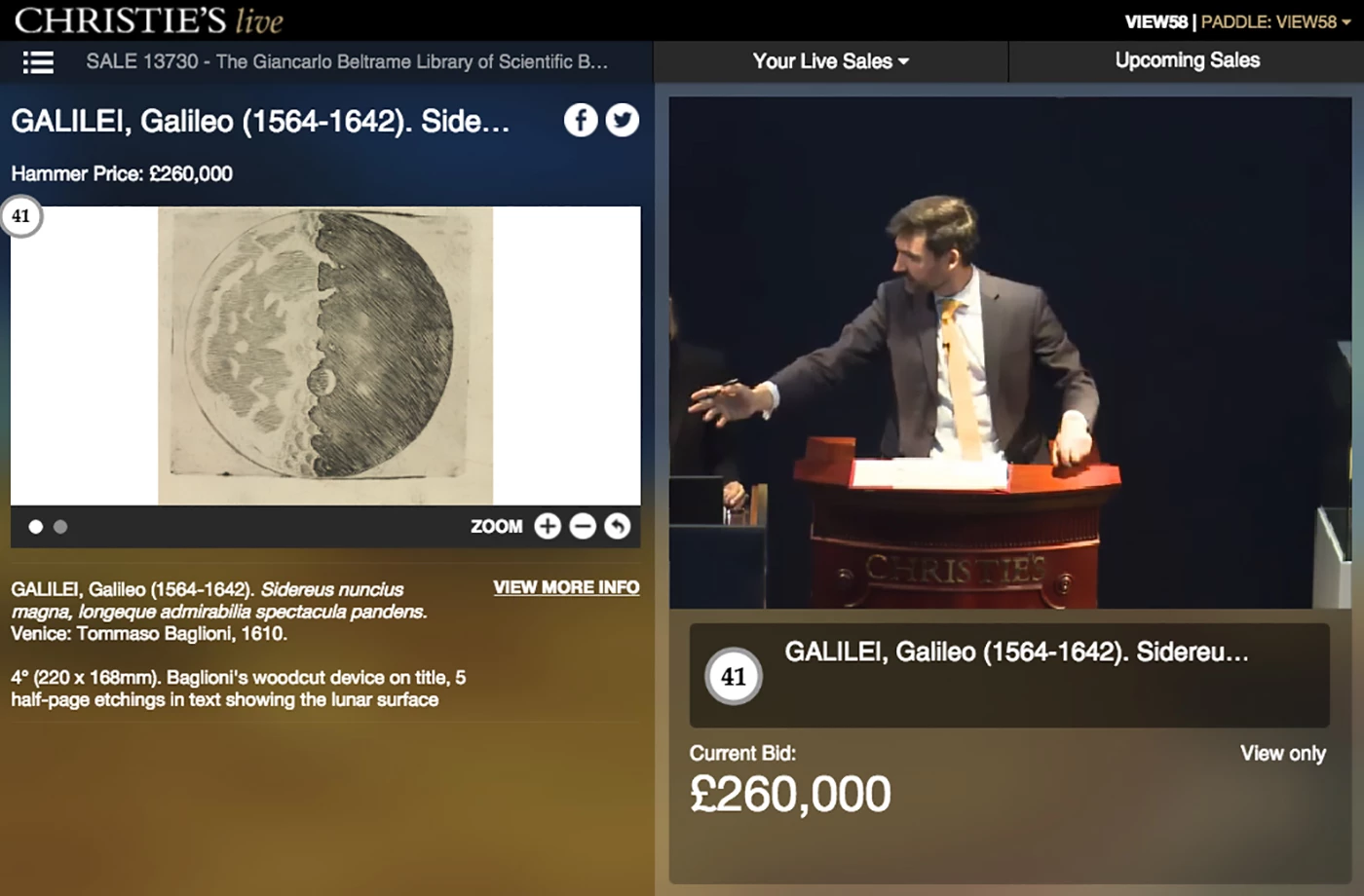
Sidereus Nuncius is one of the landmark scientific publications in history. Written by Italian polymath Galileo Galilei (1564 - 1642), the book introduced the world to his astronomical discoveries made using his home-made telescope, and is hence the foundation work of modern astronomy. Even the word "telescope" was not even coined until the year after this book was published – Galileo refers to the device in this book as a "perspicillum."
Galileo did not invent the telescope, but when he heard about the device being built in Holland in 1609, he set about making his own. Within a few months, he had improved upon his first X9 magnification to a X32 magnification, pointed it towards the heavens and then published his observations in this book in 1610. Those observations included the first details of Jupiter's four moons and his revelations about galaxies such as the Milky Way consisting of numerous stars. The drawings he made of the craters of the moon were published in this book for the first time and, building upon the previously published work of Nicolaus Copernicus, helped to change mankind's understanding of the universe from a geocentric (everything revolves around the Earth) model to a heliocentric (centered on the Sun) model.
The conflict Galileo's discoveries created with the Catholic Church finally resulted in Galileo being sentenced to house arrest for the remainder of his life. Remarkably, four centuries and 120 lunar spacecraft missions later, the church has yet to fully come to terms with the injustices committed against Galileo.
The copy auctioned yesterday sold for £314,500 ($415,464), with the record price for the book being $662,500 which was achieved at a Christie's (New York) auction in December, 2010.
$320,350 – Le operazioni del compasso geometrico by Galileo Galilei
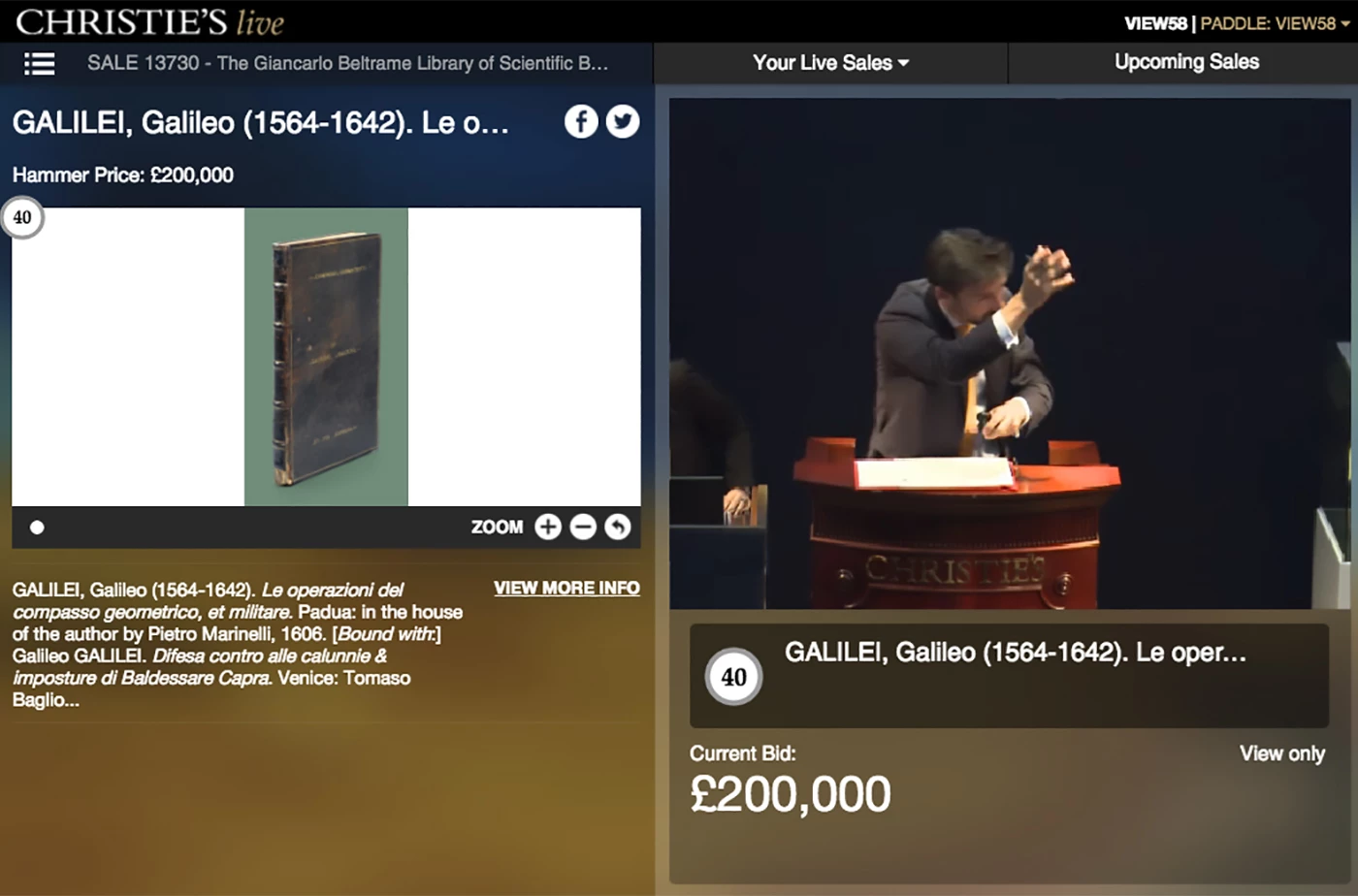
A rare first edition of Galileo's first printed work and the first published work on an analogue calculator, which Galileo had begun manufacturing in 1597. The book is believed to be one of only 60 copies produced by Galileo for patrons and buyers of his "geometrical and military compass." Galileo's sector was based on the proportional compass, an instrument first developed by Federico Commandino (1509 – 1575), but Galileo's version included numerous additions and improvements that rendered it the most useful mathematical instrument of its period. As a calculating device, Galileo's compass remained unsurpassed until the advent of the slide rule in the mid-19th-century. The book sold for £242,500 ($320,350).
$383,759 – Aequatorium Astronomicum by Johannes Schöner
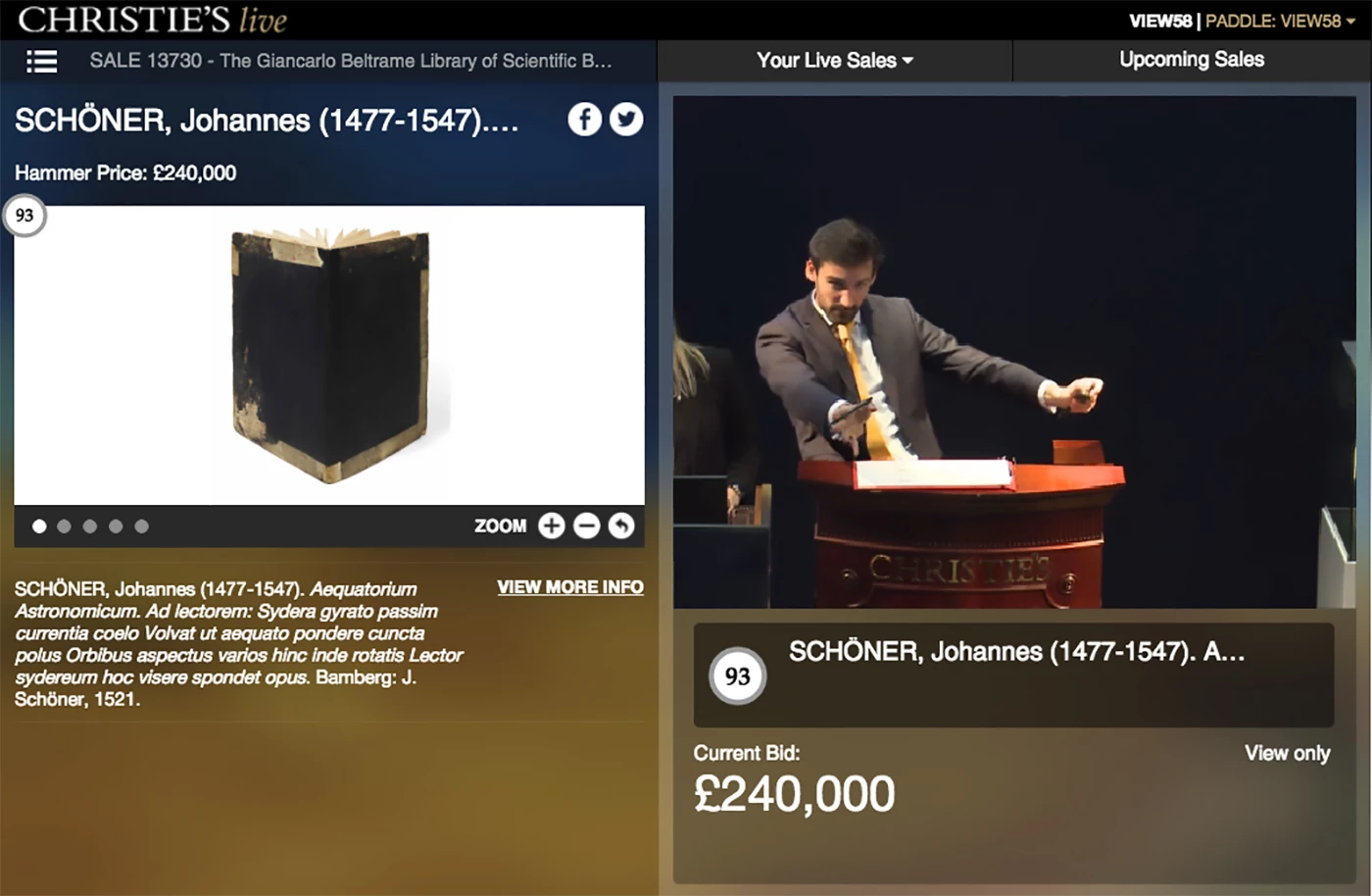
Johannes Schöner (1477 – 1547) was a priest with an interest in mathematics and astronomy and became one of the most influential figures of the period. His own printing press produced this book, which is a rarer occurrence than even the book itself, with only five copies extant, and this being the first time one has ever gone to auction. The reason it is so important is that it is the first book to contain printed equatoria, and the first book to contain printed instruments which predict the position of the planets. One of the many benefits of the newly invented printing press at the time, was the ability to create printed instruments – a significant saving in cost over metallic instruments. Schöner was also the person who persuaded Georg Joachim Rheticus to make his famous journey to meet Nicolaus Copernicus, resulting in the publication of De Libris Revolutionum in 1540, and of the landmark De Revolutionibus Orbium Coelestium in 1543. Schöner was also responsible for producing the first pair of globes of the same size to represent the Earth and the heavens, thereby establishing the standard practice of pairing terrestrial and celestial globes.
This copy of Aequatorium Astronomicum fetched £290,500 ($383,759).
$352,054 – Philosophiae Naturalis Principia Mathematica by Isaac Newton
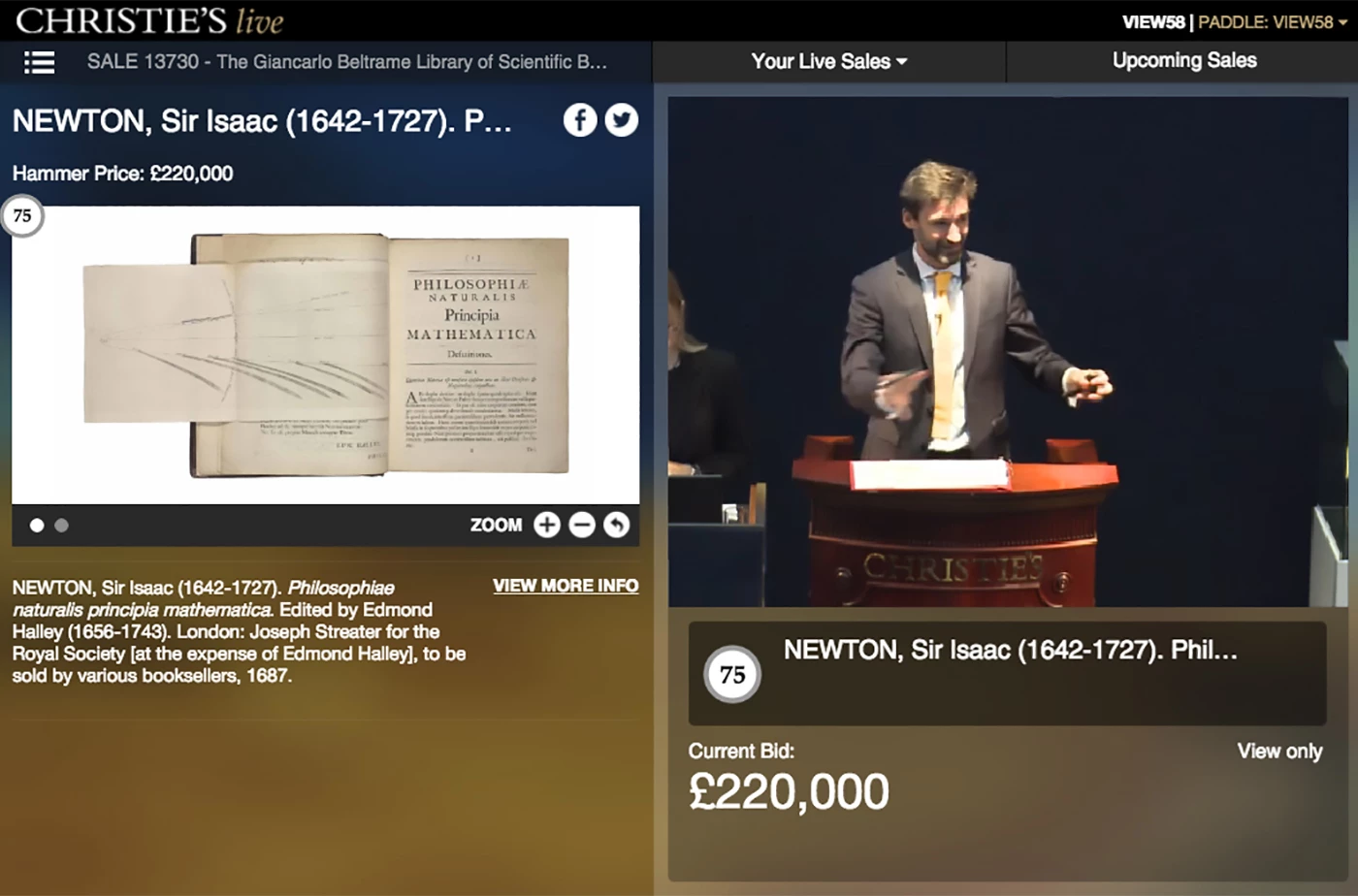
No single published body of work has ever had the impact upon the world that this book did. Principia and Newton's subsequent Opticks both became cornerstones of scientific thought. Isaac Newton (1642-1727) was knighted in 1705 by Queen Anne, but there have been many people knighted for far less justification. Newton's Philosophiae Naturalis Principia Mathematica was the culmination of the scientific revolution, effectively ushering in the era of modern science and modern physics with its mathematical explanations for gravity and motion. Albert Einstein best summed it up with the words, "perhaps the greatest intellectual stride that it has ever been granted to any man to make." Isaac Newton composed the work during 1685 and 1686, it was published on 5 July 1687 and the world record price for a copy is $2,517,000 set at a Christie's (New York) auction in December, 2013. This copy of Philosophiae Naturalis Principia Mathematica sold for £266,500 ($352,054).
$256,940 – Divina Proportione by Luca Pacioli

Franciscan friar Luca Pacioli is one of history's most influential figures. For starters, he was the man who taught mathematics to Leonardo da Vinci, but he is significantly more important than that because his publication Summa di Aritmetica Geometria Proporzioni e Proporzionalita was the first work on general mathematics ever printed, and most importantly, it was the first book to offer a detailed description of the double-entry accounting system, making Pacioli the "Father of Accounting". Many of the illustrations for Divina Proportione were done by Pacioli's star pupil, Leonardo. This particular book is a first edition and contains three works, being Divina Proportione (a summary of Euclid's propositions on the golden section), a second work on architecture, inspired by Vitruvius and Alberti, and an Italian translation of a Latin treatise of geometry by Piero della Francesca. Rare and in excellent condition, the book sold for £194,500 ($256,940).
The market for scientific memorabilia, scientific instruments and and scientific documents and manuscripts has been undervalued for ... well, forever. Our scientific heritage has long played second fiddle to entertainment, sports and religious memorabilia on the auction block, but movement is afoot.
The bidding strength at Christie's two big auctions in London yesterday indicates that the scientific heritage marketplace may be finally coming to its senses, with many landmark scientific works fetching quite respectable sums, and two lots selling into the top 20 most valuable scientific documents ever sold at auction.
As you may have gathered from our extensive feature on Einstein memorabilia last week, we're devotees of the gentle genius, so let's start with the lots associated with the rock star scientist.
$352,054 – Einstein's Pocket Watch

The Einstein highlight turned out not to be his leather jacket (as we expected), but his pocket watch, which fetched more than ten times its estimate. Predicted by Christies to sell for between £15,000 and £20,000, bidding kept going all the way to a hammer price of £220,000 which translated into £266,500 with buyers premium added and a final result in USD of $352,054.
$145,974 – Einstein's Leather Jacket

By contrast, Einstein's "putrid" (they obviously don't recognize the smell of genius) leather jacket only doubled its auction estimate of £40,000 to £60,000, hammering at £90,000 (that's screen grab from the Christie's on-line viewing interface above), which translated to £110,500 with buyers premium, which in turn became US$145,974.
$82,564 – Einstein's Childhood Building Blocks

Einstein's childhood building blocks were an even greater surprise package. Estimated to sell for between £5,000 to £8,000, the blocks saw the hammer fall at £50,000, which became £62,500 with buyers premium, or USD$82,564. We had a good laugh in the office this morning wondering what the buyer might do with the blocks. One theory was that there's a parent out there hoping that some residual genius might be be still on the surface of the blocks to rub off on their children, another is that the 160 building blocks could be separated and sold individually (they cost the buyer more than $500 apiece so heaven knows what the asking price might be for each block to make it all worthwhile), and a third theory was that they might be replicated and sold as a set. Of course it could always be a genuine collector who purchased the blocks but ... time will tell.
$98,417 - a postcard from Albert Einstein

Finally, a 140 x 90mm correspondence card handwritten and signed by Einstein to his friend Albert Karr in 1919, fetched £74,500 ($98,417) from an estimate of £25,000 to £35,000. Again, that's better than double the upper estimate.
In summary, the Einstein "Midas touch" appears to be getting more potent with age. If Einstein memorabilia is an area of interest for you, be sure to see our extensive compendium of Einstein auction results.
A pocket watch, leather jacket and some building blocks may have created the interest in the auctions, but it was the world's most famous flower book, the original book on heliocentric theory and a number of landmark works by Sir Isaac Newton, Galileo Galilei, Johannes Schoner and Luca Pacioli that really lit up Christie's London sales.
$2,550,247 – Hortus Eystettensis by Basilius Besler

The 400 year-old Hortus Eystettensis by Basilius Besler attracted considerable interest from around the globe as one of just 15 complete copies of the "most famous flower book in the world."
It was already the second most valuable flower book in history with a copy having sold for £993,750 ($1,413,619) at a Christies London auction in November, 2001 so it was no surprise to see it fetch considerably more than the estimate of £800,000 to £1,200,000 (US$1.2 to $1.6 million). When the hammer fell, the final all up price took the book to £1,930,500 ($2,550,247) and a place just outside the top 10 scientific books of all time. The most valuable 'flower book' of all time is currently Les Liliacées by Pierre-Joseph Redouté which sold for $5,500,000 at a Sotheby's (New York) auction in November, 1985.
$2,402,292 – De Libris Revolutionum by Rheticus

As we predicted last week in our preview of this lot, this copy of De Libris Revolutionum Eruditissimi Viridoctoris sold above it's £1,200,000 – £1,800,000 estimate as it is exceedingly rare and the last time a copy came to auction was at a Sotheby's New York auction in November 1989. In the end, it fetched £1,818,500 ($2,402,292), which is somewhat ironic as the book is the work of Georg Joachim Rheticus, and is based on his studies under Nicolaus Copernicus, the person credited with the heliocentric theory. When published in 1540, this book provided the momentum needed for Copernicus to finally have his landmark De Revolutionibus Orbium Coelestium published in 1543.
The irony comes from the fact that this book sold for more than the most valuable first edition copy of his master's master work which sold for $2,210,500 at a Christie's (New York) auction in June 2008.
$415,464 – Sidereus Nuncius by Galileo Galilei

Sidereus Nuncius is one of the landmark scientific publications in history. Written by Italian polymath Galileo Galilei (1564 - 1642), the book introduced the world to his astronomical discoveries made using his home-made telescope, and is hence the foundation work of modern astronomy. Even the word "telescope" was not even coined until the year after this book was published – Galileo refers to the device in this book as a "perspicillum."
Galileo did not invent the telescope, but when he heard about the device being built in Holland in 1609, he set about making his own. Within a few months, he had improved upon his first X9 magnification to a X32 magnification, pointed it towards the heavens and then published his observations in this book in 1610. Those observations included the first details of Jupiter's four moons and his revelations about galaxies such as the Milky Way consisting of numerous stars. The drawings he made of the craters of the moon were published in this book for the first time and, building upon the previously published work of Nicolaus Copernicus, helped to change mankind's understanding of the universe from a geocentric (everything revolves around the Earth) model to a heliocentric (centered on the Sun) model.
The conflict Galileo's discoveries created with the Catholic Church finally resulted in Galileo being sentenced to house arrest for the remainder of his life. Remarkably, four centuries and 120 lunar spacecraft missions later, the church has yet to fully come to terms with the injustices committed against Galileo.
The copy auctioned yesterday sold for £314,500 ($415,464), with the record price for the book being $662,500 which was achieved at a Christie's (New York) auction in December, 2010.
$320,350 – Le operazioni del compasso geometrico by Galileo Galilei

A rare first edition of Galileo's first printed work and the first published work on an analogue calculator, which Galileo had begun manufacturing in 1597. The book is believed to be one of only 60 copies produced by Galileo for patrons and buyers of his "geometrical and military compass." Galileo's sector was based on the proportional compass, an instrument first developed by Federico Commandino (1509 – 1575), but Galileo's version included numerous additions and improvements that rendered it the most useful mathematical instrument of its period. As a calculating device, Galileo's compass remained unsurpassed until the advent of the slide rule in the mid-19th-century. The book sold for £242,500 ($320,350).
$383,759 – Aequatorium Astronomicum by Johannes Schöner

Johannes Schöner (1477 – 1547) was a priest with an interest in mathematics and astronomy and became one of the most influential figures of the period. His own printing press produced this book, which is a rarer occurrence than even the book itself, with only five copies extant, and this being the first time one has ever gone to auction. The reason it is so important is that it is the first book to contain printed equatoria, and the first book to contain printed instruments which predict the position of the planets. One of the many benefits of the newly invented printing press at the time, was the ability to create printed instruments – a significant saving in cost over metallic instruments. Schöner was also the person who persuaded Georg Joachim Rheticus to make his famous journey to meet Nicolaus Copernicus, resulting in the publication of De Libris Revolutionum in 1540, and of the landmark De Revolutionibus Orbium Coelestium in 1543. Schöner was also responsible for producing the first pair of globes of the same size to represent the Earth and the heavens, thereby establishing the standard practice of pairing terrestrial and celestial globes.
This copy of Aequatorium Astronomicum fetched £290,500 ($383,759).
$352,054 – Philosophiae Naturalis Principia Mathematica by Isaac Newton

No single published body of work has ever had the impact upon the world that this book did. Principia and Newton's subsequent Opticks both became cornerstones of scientific thought. Isaac Newton (1642-1727) was knighted in 1705 by Queen Anne, but there have been many people knighted for far less justification. Newton's Philosophiae Naturalis Principia Mathematica was the culmination of the scientific revolution, effectively ushering in the era of modern science and modern physics with its mathematical explanations for gravity and motion. Albert Einstein best summed it up with the words, "perhaps the greatest intellectual stride that it has ever been granted to any man to make." Isaac Newton composed the work during 1685 and 1686, it was published on 5 July 1687 and the world record price for a copy is $2,517,000 set at a Christie's (New York) auction in December, 2013. This copy of Philosophiae Naturalis Principia Mathematica sold for £266,500 ($352,054).
$256,940 – Divina Proportione by Luca Pacioli

Franciscan friar Luca Pacioli is one of history's most influential figures. For starters, he was the man who taught mathematics to Leonardo da Vinci, but he is significantly more important than that because his publication Summa di Aritmetica Geometria Proporzioni e Proporzionalita was the first work on general mathematics ever printed, and most importantly, it was the first book to offer a detailed description of the double-entry accounting system, making Pacioli the "Father of Accounting". Many of the illustrations for Divina Proportione were done by Pacioli's star pupil, Leonardo. This particular book is a first edition and contains three works, being Divina Proportione (a summary of Euclid's propositions on the golden section), a second work on architecture, inspired by Vitruvius and Alberti, and an Italian translation of a Latin treatise of geometry by Piero della Francesca. Rare and in excellent condition, the book sold for £194,500 ($256,940).
